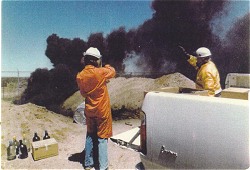| Even though the U of A has
been dumping deadly radioactive and toxic chemical lab waste at Page-Trowbridge
for three or more decades, the existence of the site is still unknown to
Pinal County officials.
This situation changes in
April of 1978.
On Thursday April 20th,
1978 a substantial column of thick black, oily smoke rises in the in the
air over Page-Trowbridge. The plume catches the attention of personnel
at Goulder Fire Department in the small town of Catalina Arizona, some
seven miles south of the radioactive dump site.
Since the Goulder Fire Department
is in Pima county and the strange and unnatural fire is clearly in Pinal
County, the firemen immediately notify the Pinal County Sheriff's department.
The Pinal County Sheriff's
department, thinking the billowing black smoke is a fuel fire from a crashed
airplane, contact Davis Monthan Air Force Base. Davis Monthan personnel
report that a plane is, in fact, overdue.
Emergency vehicles from both
the Pinal County Sheriff's and Fire Departments roll to the scene, lights
flashing and sirens screaming.
 |
|
Burning Toxic Waste
At Page-Trowbridge, Circa Mid '70's, Photo by Jim Glaze
|
The Pinal County authorities
arrive to discover several U of A employees standing around a burning
pit belching copious amounts of sooty black smoke into the otherwise pristine
springtime air.
The Pinal County authorities
threaten the U of A personnel with arrest.
The U of A employees explain
that this is a standard operating procedure that has been going on every
month for at least ten years. The U of A employees offer the the myriad
covered pits as proof of the fact that this is far from an isolated incident,
and the U of A personnel are allowed to leave the scene.
|
![]()
![]() email:mekazda@mindspring.com
email:mekazda@mindspring.com